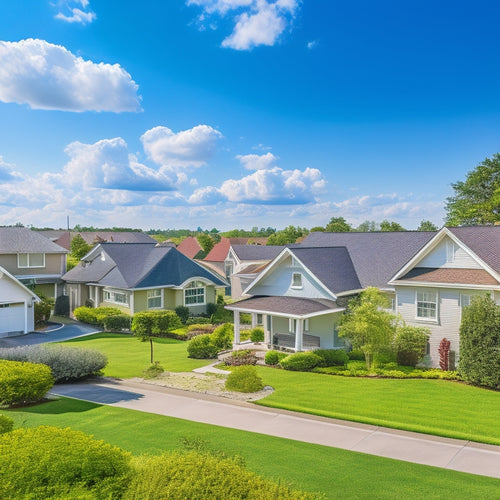
Top Roof Insulation Techniques for Energy-Smart Homes
Share
When creating an energy-smart home, selecting the right roof insulation technique is essential. You'll want to take into account factors like climate, budget, and personal preferences when choosing from eco-friendly options like recycled denim, wool, and fiberglass. Radiant barriers, fiberglass batt insulation, and spray foam methods offer varying R-values and energy savings. Cellulose insulation provides higher R-values and sustainability benefits, while rigid foam boards and insulated concrete forms (ICFs) offer high performance and durability. By understanding these techniques and their benefits, you can make informed decisions to optimize your roof's energy efficiency - and there's even more to investigate in the world of energy-smart roofing.
Key Takeaways
- Selecting the right insulation material is crucial for energy efficiency, considering factors like climate, budget, and personal preferences.
- Radiant barrier installation can provide up to 97% energy savings by reflecting heat and preventing attic heat gain during summer.
- Fiberglass batt insulation is a budget-friendly option with an R-value ranging from R-3.5 to R-4.3 per inch, suitable for DIY installation.
- Spray foam insulation requires critical factors like foam density, application thickness, and ventilation to ensure effectiveness and longevity.
- Insulated Concrete Forms (ICFs) offer thermal mass benefits, strength, and durability, making them suitable for new and retrofit applications.
Insulation Materials for Roofing
Selecting the right insulation material for your roofing project is essential, as it directly impacts the energy efficiency, durability, and overall performance of your roof.
You'll want to take into account factors like climate, budget, and personal preferences when choosing the best insulation for your home.
For ideal insulation performance, you may opt for eco-friendly options like recycled denim, wool, or fiberglass.
In addition, incorporating sustainable road trip amenities into your design can further enhance the energy efficiency of your home.
These materials not only reduce energy consumption but also minimize environmental impact.
Other considerations include R-value, moisture resistance, and installation requirements.
Radiant Barrier Installation
Your attic's scorching summer temperatures can be drastically reduced with a properly installed radiant barrier. This energy-efficient solution prevents heat gain by reflecting radiation rather than absorbing it. You can choose from three primary radiant barrier types: foil-faced, foil-backed, and mass-type. Each has its benefits, but foil-faced barriers are the most popular due to their high reflectivity and ease of installation.
| Radiant Barrier Type | Installation Benefits | Energy Savings |
|---|---|---|
| Foil-Faced | Easy to install, high reflectivity | Up to 97% |
| Foil-Backed | Cost-effective, durable | Up to 95% |
| Mass-Type | High-density, long-lasting | Up to 90% |
| --- | --- | --- |
| --- | --- | --- |
Fiberglass Batt Insulation
You'll find that fiberglass batt insulation is a straightforward installation process, requiring minimal specialized labor or equipment.
As an affordable option, it's a cost-effective way to reduce heat transfer in your roof.
By integrating solar panels renewable energy sources, you can further minimize energy consumption and reduce your carbon footprint.
Easy to Install
Two of the most popular insulation materials for roofs are fiberglass batt insulation and reflective insulation. When it comes to easy installation techniques, fiberglass batt insulation is a top choice. You'll appreciate its user-friendly materials that make it a breeze to work with.
| Feature | Fiberglass Batt Insulation |
|---|---|
| Installation Method | Friction-fit between joists |
| R-Value | R-3.5 to R-4.3 per inch |
| Material Cost | $0.50 to $1.50 per sq. ft. |
| Installation Time | 1-2 hours per 100 sq. ft. |
| Skill Level | DIY-friendly, minimal training required |
With fiberglass batt insulation, you can achieve energy efficiency without the hassle of complex installation processes. Its easy-to-handle material and straightforward installation method make it an ideal choice for homeowners seeking freedom from energy waste.
Affordable Option Available
Since budget constraints often dictate the choice of insulation material, it's reassuring to know that fiberglass batt insulation offers an affordable option for homeowners.
You can achieve significant energy savings without breaking the bank. As a budget-friendly material, fiberglass batt insulation provides an effective energy-saving strategy for your roof.
When evaluating energy efficiency, it's crucial to assess energy needs and infrastructure to guarantee peak performance. It's a cost-effective solution that won't compromise on performance.
By choosing fiberglass batt insulation, you can redirect your savings towards other vital aspects of your energy-smart home.
With its affordability and energy-saving capabilities, fiberglass batt insulation is an attractive option for homeowners seeking freedom from high energy bills.
Reduces Heat Transfer
Across various climates and seasons, heat transfer through your roof can greatly impact your energy consumption and expenses.
Fiberglass batt insulation reduces heat transfer by trapping air pockets between its fibers, thereby minimizing heat retention. This results in improved energy efficiency, as your HVAC system doesn't have to work as hard to maintain a comfortable indoor temperature.
By installing fiberglass batt insulation in your attic, you can considerably reduce heat transfer during winter and summer.
Furthermore, incorporating renewable energy solutions like solar panels or hybrid electric solutions can further reduce your reliance on fossil fuels and lower your carbon footprint.
This, in turn, leads to lower energy bills and a more sustainable living space.
With fiberglass batt insulation, you'll enjoy a more energy-efficient home that's better equipped to handle extreme temperatures.
Spray Foam Insulation Methods
When you apply spray foam insulation, you'll need to take into account three critical factors to guarantee peak performance.
First, you must specify the correct foam density for your project, as it directly affects the material's R-value and durability.
You'll also need to control application thickness and guarantee proper ventilation to prevent moisture buildup and compromised structural integrity.
Moreover, homeowners can greatly reduce their energy costs by investing in energy-efficient solutions, such as electric vehicles electric vehicles, which can save up to $14,500 on fuel costs over 15 years.
Additionally, energy-efficient charging plans can be fine-tuned to minimize electricity costs.
Foam Density Matters
Your spray foam gun is loaded and ready to go, but before you start applying that foam, it's crucial to understand the importance of foam density.
Foam density directly impacts foam performance and insulation lifespan. A higher density foam provides better insulation, as it has a lower air permeability, reducing heat transfer and convection. It also increases the foam's durability, ensuring a longer insulation lifespan.
Conversely, low-density foam can lead to reduced R-values, compromised structural integrity, and a shorter lifespan. To achieve ideal results, you must maintain the correct foam density, which is typically between 1.8 and 2.2 pounds per cubic foot for open-cell foam and 2.0 to 2.5 pounds per cubic foot for closed-cell foam.
Application Thickness Control
Achieving ideal insulation performance hinges on controlling the application thickness of spray foam insulation, as it directly impacts the overall R-value and energy efficiency of the building envelope.
You need to guarantee consistency in application techniques to achieve peak results. To do this, focus on the following key aspects:
-
Calibrated equipment: Use spray foam equipment that's calibrated to deliver the correct amount of material, securing consistent application thickness.
-
Visual inspection: Conduct regular visual inspections during application to identify any inconsistencies or defects.
-
Thickness verification: Verify the application thickness using measurement tools, such as calipers or thickness gauges, to confirm it meets the specified requirements.
Proper Ventilation Needed
Proper ventilation is essential to guarantee the effectiveness and longevity of spray foam insulation.
You must confirm that your roofing system allows for adequate air circulation to prevent moisture buildup. Without proper ventilation, spray foam insulation can become saturated with moisture, reducing its R-value and leading to structural damage.
Install a ventilation system that provides a clear path for air to circulate through the roof. This can be achieved through soffit vents, ridge vents, or power ventilators.
Cellulose Insulation Benefits
Since cellulose insulation is made from recycled materials, it offers a unique set of benefits that set it apart from other insulation options.
By choosing cellulose, you're not only reducing your energy consumption but also minimizing your environmental impact. This eco-friendly insulation is also an effective soundproofing solution, providing a quieter living space.
Here are three key benefits of cellulose insulation:
-
Higher R-Value: Cellulose has a higher R-value than traditional insulation materials, making it a more effective insulator.
-
Improved Air Quality: Cellulose is resistant to mold and mildew, ensuring a healthier indoor environment.
-
Fire-Resistant: Cellulose is treated with fire retardants, providing an added layer of safety for your home.
Rigid Foam Board Installation
As you prepare to install rigid foam board insulation, it's essential to understand the importance of correct placement and secure fastening to guarantee peak performance.
Rigid foam boards offer several advantages, including high R-value, durability, and resistance to moisture. However, installation challenges can arise if not done correctly.
Confirm the surface is clean, dry, and level before applying the foam boards. Use compatible adhesives and fasteners to secure the boards, and avoid gaps or cracks that can compromise performance.
Properly installed rigid foam boards can provide long-term energy efficiency and comfort in your energy-smart home. By following these guidelines, you'll be able to utilize the benefits of rigid foam insulation and enjoy a more comfortable, cost-effective living space.
Reflective Insulation Systems
Across various climates and building types, reflective insulation systems have gained popularity due to their unique ability to reduce heat gain during summer and heat loss during winter.
By installing reflective insulation, you can enjoy significant energy savings and a more comfortable living space.
The benefits of reflective insulation are numerous, including:
-
Reduced energy consumption: Reflective insulation helps to minimize heat transfer, reducing the load on your HVAC system and saving you money on energy bills.
-
Increased comfort: By reducing temperature fluctuations, reflective insulation guarantees a consistent and comfortable indoor climate.
-
Versatile applications: Reflective insulation can be used in various building types, from residential to commercial and industrial, and is suitable for new constructions and retrofits alike.
Insulated Concrete Forms
You'll find that insulated concrete forms (ICFs) offer a unique combination of thermal mass benefits, strength, and durability.
By incorporating ICFs into your roofing design, you can create a structure that absorbs and releases heat slowly, reducing temperature fluctuations and energy costs.
Additionally, ICFs provide exceptional resistance to natural disasters and last longer than traditional building materials.
Thermal Mass Benefits
Within well-designed buildings, insulated concrete forms (ICFs) utilizing thermal mass benefits offer a unique opportunity to regulate interior temperatures and reduce the need for HVAC systems.
By understanding thermal behavior, you can optimize your building's energy conservation.
Here are three key advantages of ICFs' thermal mass benefits:
-
Temperature Regulation: ICFs absorb and release heat, reducing temperature fluctuations and maintaining a comfortable indoor climate.
-
Energy Efficiency: By reducing the load on HVAC systems, you'll conserve energy and lower your utility bills.
-
Passive Design: ICFs enable passive design strategies, allowing you to utilize natural light and heat, further reducing your reliance on mechanical systems.
Strength and Durability
As you optimize your building's energy conservation through thermal mass benefits, it's equally important to contemplate the structural integrity of your insulated concrete forms (ICFs).
You want to ascertain your ICFs can withstand various environmental conditions and loads over their lifespan. To achieve this, focus on material selection that guarantees long-term performance.
Look for materials with high compressive strength, durability, and resistance to natural disasters like earthquakes and hurricanes. Additionally, consider using reinforced materials that can absorb and distribute stresses evenly.
Roof Insulation R-Value Matters
Most buildings require a minimum R-value of R-38 in their roofs, but this varies depending on the climate zone and local building codes.
As you plan your energy-smart home, it's important to understand the R-value of your roof insulation. R-value measures the insulation's ability to resist heat flow, and a higher value indicates better insulation performance.
When comparing insulation options, consider the following factors that affect R-value:
- Material type: Different materials have varying R-values per inch of thickness. For example, fiberglass batts have an R-value of R-3.5 per inch, while spray foam has an R-value of R-6.5 per inch.
- Thickness: Increasing the thickness of the insulation material generally increases its R-value.
- Installation: Proper installation is critical to achieving the rated R-value of the insulation material.
DIY Vs Professional Installation
Your insulation installation choice - DIY or professional - greatly impacts the overall performance and longevity of your roof insulation. When deciding, consider the cost comparison and installation techniques involved.
| DIY Installation | Professional Installation |
|---|---|
| Lower upfront cost | Higher upfront cost, but potential long-term savings |
| May require more time and effort | Quicker installation with expert techniques |
| Risk of incorrect installation | Warranty and guarantee provided |
| Limited access to specialized tools | Access to specialized tools and equipment |
Frequently Asked Questions
Can I Install Roof Insulation in an Existing Home?
You can install roof insulation in your existing home, but consider DIY insulation costs and feasibility; hiring a pro might be more effective, especially if you're not comfortable with the process, ensuring a more efficient and cost-saving outcome.
How Long Does Roof Insulation Typically Last?
You'll find that roof insulation's lifespan depends on material durability; fiberglass batts last around 20-30 years, while spray foam and rigid foam board can last up to 50 years or more with proper installation and maintenance.
Are There Any Roof Insulation Options for Flat Roofs?
"When in Rome, do as the Romans do" - and for flat roofs, you'll want to do it right! You can opt for specialized flat roof materials like modified bitumen or EPDM, and guarantee proper insulation installation to maximize energy efficiency and minimize heat loss.
Can Roof Insulation Help Reduce Noise Pollution?
You can effectively combat noise pollution by incorporating soundproofing materials with high acoustic performance into your roof insulation, greatly reducing external noise penetration and creating a more peaceful living environment that's all yours.
Are There Any Local Building Codes for Roof Insulation?
You're maneuvering a maze of regulations, and finding the right roof insulation is like finding the exit. Check your local building codes, as they dictate the minimum R-value and approved insulation materials, ensuring you meet regional energy efficiency standards while enjoying autonomy.
Related Posts
-

What Tax Deductions Apply to Sustainable Building Materials?
You can claim various tax deductions for sustainable building materials, thanks to over 40 federal tax incentives sup...
-

What Cool Roof Tax Breaks Can Homeowners Claim?
You can claim federal tax credits of up to $500 and state and local incentives for installing cool roofs, which not o...
-

What Water-Saving Gardens Complement Electric Vehicle Ownership?
As you pair your electric vehicle with a water-saving garden, you're not only reducing your carbon footprint but also...


